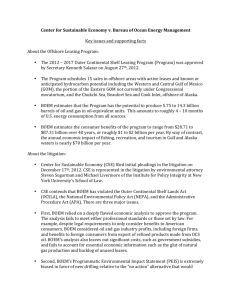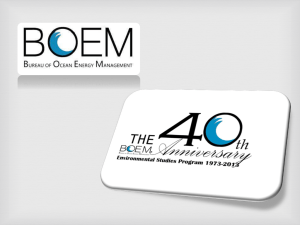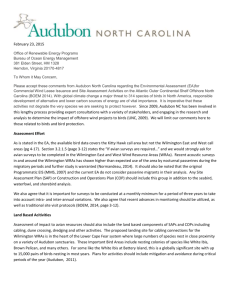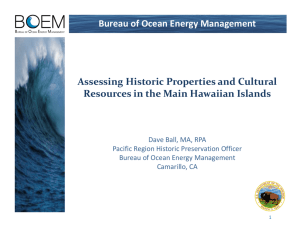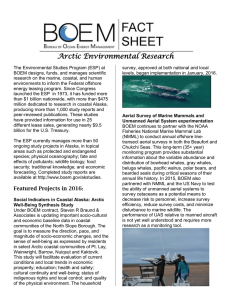NTL 2016-N01
advertisement
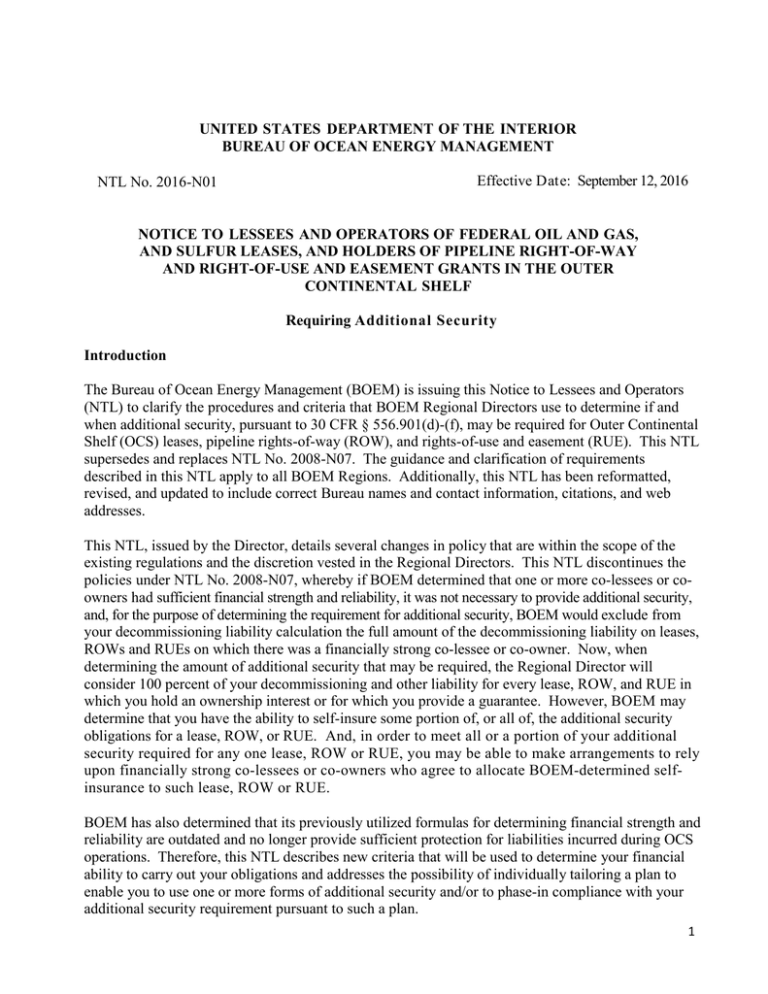
UNITED STATES DEPARTMENT OF THE INTERIOR BUREAU OF OCEAN ENERGY MANAGEMENT NTL No. 2016-N01 Effective D at e: September 12, 2016 NOTICE TO LESSEES AND OPERATORS OF FEDERAL OIL AND GAS, AND SULFUR LEASES, AND HOLDERS OF PIPELINE RIGHT-OF-WAY AND RIGHT-OF-USE AND EASEMENT GRANTS IN THE OUTER CONTINENTAL SHELF Requiring Addi tional Security Introduction The Bureau of Ocean Energy Management (BOEM) is issuing this Notice to Lessees and Operators (NTL) to clarify the procedures and criteria that BOEM Regional Directors use to determine if and when additional security, pursuant to 30 CFR § 556.901(d)-(f), may be required for Outer Continental Shelf (OCS) leases, pipeline rights-of-way (ROW), and rights-of-use and easement (RUE). This NTL supersedes and replaces NTL No. 2008-N07. The guidance and clarification of requirements described in this NTL apply to all BOEM Regions. Additionally, this NTL has been reformatted, revised, and updated to include correct Bureau names and contact information, citations, and web addresses. This NTL, issued by the Director, details several changes in policy that are within the scope of the existing regulations and the discretion vested in the Regional Directors. This NTL discontinues the policies under NTL No. 2008-N07, whereby if BOEM determined that one or more co-lessees or coowners had sufficient financial strength and reliability, it was not necessary to provide additional security, and, for the purpose of determining the requirement for additional security, BOEM would exclude from your decommissioning liability calculation the full amount of the decommissioning liability on leases, ROWs and RUEs on which there was a financially strong co-lessee or co-owner. Now, when determining the amount of additional security that may be required, the Regional Director will consider 100 percent of your decommissioning and other liability for every lease, ROW, and RUE in which you hold an ownership interest or for which you provide a guarantee. However, BOEM may determine that you have the ability to self-insure some portion of, or all of, the additional security obligations for a lease, ROW, or RUE. And, in order to meet all or a portion of your additional security required for any one lease, ROW or RUE, you may be able to make arrangements to rely upon financially strong co-lessees or co-owners who agree to allocate BOEM-determined selfinsurance to such lease, ROW or RUE. BOEM has also determined that its previously utilized formulas for determining financial strength and reliability are outdated and no longer provide sufficient protection for liabilities incurred during OCS operations. Therefore, this NTL describes new criteria that will be used to determine your financial ability to carry out your obligations and addresses the possibility of individually tailoring a plan to enable you to use one or more forms of additional security and/or to phase-in compliance with your additional security requirement pursuant to such a plan. 1 Authority and Background BOEM regulations at 30 CFR part 556, Subpart I, set forth a multi-tiered financial assurance system applicable to oil and gas, and sulfur leases to ensure that OCS obligations will be met. There are three stages in the life of a lease when financial assurance is required by regulation: (1) lease issuance, (2) approval of an exploration plan, and (3) approval of a development and production plan or a development operations coordination document (see 30 CFR §§ 556.900(a), and 556.901(a) & (b)). However, at any time, the Regional Director may determine that additional security is necessary (30 CFR § 556.901(d)). BOEM regulations contain similar financial assurance requirements applicable to ROWs and RUEs. The additional security regulation applicable to ROWs is found at 30 CFR § 550.1011(a)(2). The additional security regulation applicable to RUEs associated with state leases is 30 CFR § 550.166(b). BOEM regulations at 30 CFR § 550.160(c) state that a Federal lessee/RUE holder must meet bonding requirements. With respect to RUEs associated with Federal leases, this NTL applies to any demand to increase the amount of the bond or other financial assurance after the initial bond is established. I. Evaluation of Your Financial Ability to Carry Out Obligations Pursuant to 30 CFR § 556.901(d)(1), the Regional Director will evaluate your financial ability to carry out your present and future obligations annually to determine whether you must provide additional security and, if so, how much additional security you must provide. Prior to beginning this review, the Regional Director may request updated information from you. Periodic reviews to evaluate your financial ability to carry out your present and future obligations and to determine appropriate levels of required additional security may be done at any time at the discretion of the Regional Director, but will likely be done when BOEM becomes aware of any: • • • • II. Material or adverse change in your financial strength or OCS obligations; Performance deficiencies, such as incidents of noncompliance, civil penalties or failure to adhere to any term or condition of, or obligation imposed by, a lease, exploration or development and production plan, development operations coordination document, or permit; Change in operator or ownership; or Violation of Department of the Interior or other applicable regulations. Factors Considered in Evaluation of Financial Ability to Carry Out Obligations and Determination of Self-Insurance You are responsible for ensuring that all obligations, including decommissioning and abandonment, are satisfied for every lease, ROW, or RUE in which you have an ownership interest. If the BOEM Regional Director determines that the financial ability of any lessee or grantee for any lease, ROW, or RUE is not sufficient to assure performance of its lease, ROW, or RUE obligations, he or she may require the lessees or ROW or RUE owners to provide and maintain additional security. In making 2 this determination, the Regional Director will consider 100 percent of your decommissioning and other liability for every lease, ROW, and RUE in which you hold an ownership interest, or for which you provide a guarantee. The Regional Director’s evaluation of your financial ability to carry out your obligations will be based on information you submit and other information in BOEM’s possession demonstrating your financial capacity, financial strength, stability, reliability, and record of compliance. The result of this evaluation will determine whether, and how much, additional security is required. Your provision of relevant information such as audited financial statements is encouraged; if it is not provided, BOEM will base its determinations on the information available to the Bureau. The Regional Director’s evaluation will consider these five criteria as provided below. 1. Financial Capacity As set forth in 30 CFR § 556.901(d)(1)(i), Financial Capacity substantially in excess of existing and anticipated lease and other obligations, as evidenced by your most recent (not more than 12 months old) audited financial statements, is demonstrated in part by applicable financial criteria, including but not limited to, those listed below, which, for the purposes of this NTL, are defined and described on the Attachment hereto: • • • • • • • • • Cash Flow from Operations/Total Debt Current Ratio Earnings Before Interest and Taxes (EBIT)/Interest Expense Quick Ratio Return on Assets Return on Equity Total Debt/Capital Total Debt/Earnings Before Interest, Taxes, Depreciation and Amortization (EBITDA) Total Debt/Equity BOEM has established minimum thresholds for each of the nine ratios above, as well as the number of such thresholds that BOEM requires you to exceed, to determine that you have Financial Capacity substantially in excess of existing and anticipated lease and other obligations. This information, as well as information concerning the manner in which BOEM will apply the other four criteria below, is available on BOEM’s website at http://www.boem.gov/Risk-Management/. BOEM may periodically update this information based upon prevailing market conditions or other relevant factors. 2. Projected Financial Strength As set forth in 30 CFR § 556.901(d)(1)(ii), Projected Financial Strength significantly in excess of existing and future lease obligations is based upon: The estimated value of your existing OCS lease production and proven reserves of future production. 3. Business Stability As set forth in 30 CFR § 556.901(d)(1)(iii), Business Stability is based upon: Five years of continuous operation and production on the OCS or onshore. 3 4. Reliability As set forth in 30 CFR § 556.901(d)(1)(iv), Reliability is based upon: Your credit rating from Moody’s or Standard and Poor’s, or your trade references. 5. Record of Compliance As set forth in 30 CFR § 556.901(d)(1)(v), your Record of Compliance is based upon: Whether you or any of your affiliates or subsidiaries: a) have been assessed civil penalties by either BOEM or the Bureau of Safety and Environmental Enforcement (BSEE); b) have been found by BOEM and/or BSEE to be non-compliant with any lease, plan, or permit term or condition; c) have been cited by any other agency(ies) with jurisdiction on the OCS, for noncompliance with any regulation; and/or d) have been cited for non-payment or under-payment of rentals, royalties, interest bills, civil penalties, or inspection fees, and such non-payment or under-payment has been referred to the U.S. Treasury for collection within the past five years. On a case-by-case basis, the Regional Director may deem a late payment(s) excusable if you present sufficient and reasonable justification detailing the extenuating circumstances that prevented timely payment(s). When evaluating your financial ability to carry out your obligations, based on the five above criteria, the Regional Director may consider information relevant to these criteria, such as: transfer(s) of working interests, production payments, and other interests; off balance sheet transaction(s); contractual default(s); suspension(s); debarment(s); and/or violation(s) of U.S. law(s). If the Regional Director determines that additional security must be provided to meet lease, ROW, and/or RUE obligations, he/she may determine, using the five criteria above that you have the ability to self-insure some portion of, or all of, the additional security obligations for a lease, ROW, or RUE. Self-insurance is the amount of your obligations for which the Regional Director has determined you have the financial ability to assure performance, but the Regional Director will not permit the use of self-insurance in an amount in excess of 10 percent (10%) of your tangible net worth, as defined in the Attachment hereto. If BOEM determines you have the ability to use self-insurance, you must notify BOEM of the amount of self-insurance you will allocate to each lease, ROW, or RUE in which you have an interest and whether it is your intent for such self-insurance to cover the interests of other parties holding interests in those leases, ROWs or RUEs. The Regional Director may determine, based on your credit rating (see Reliability criterion above), that you cannot apply your self-insurance to sole liability properties. The minimum credit rating that a party must have to be allowed to apply its self-insurance to sole liability properties will be available on BOEM’s website and subject to periodic adjustment. Sole liability properties are leases, ROWs, or RUEs for which you are the only liable party, i.e. there are no co-lessees and/or other grant holders, and no prior interest holders who would be liable to BOEM to meet the obligations arising from such properties. 4 If the Regional Director determines that you do not have the ability to self-insure, or you believe that your ability to self-insure is greater than that determined by the Regional Director, the Regional Director may allow you to submit, for his or her consideration, other evidence that you believe is of equal relevance to those criteria listed above. Based on his or her review of this other evidence, the Regional Director may change his or her determination. III. Determination of Amount of Additional Security and Notification If the Regional Director determines that your financial ability to carry out your obligations, along with your existing financial assurance and the amount of self-insurance you or others have allocated to each lease, ROW or RUE in which you have an interest, is not sufficient to cover your OCS obligations, you must provide additional security. The Regional Director will notify you in writing, through your designated operator for leases, RUE holder-of-record for RUEs, or ROW-holder-of-record for ROWs, of the amount of additional security required. The designated operator is required to coordinate with the lessees to provide the amount of additional security required for each lease. The RUE holder-ofrecord and the ROW holder-of-record are required to provide the amount of additional security required for each RUE and ROW, respectively. The Regional Director’s notification will either (1) propose an amount of additional security required, and give you the opportunity to meet with BOEM, within a specified period of time, to discuss this amount; or (2) order that within a specified period of time, you provide the required additional security or present to BOEM a tailored plan to meet your additional security requirement. Additional security for sole liability properties cannot be phased-in. Therefore the order will include a listing of (1) the sole liability properties for which BOEM will not allow a phased-in timetable for compliance; and (2) the properties for which BOEM will allow phased-in compliance to meet your additional security requirement pursuant to a tailored plan, as set forth below. IV. Acceptable Forms of Additional Security If the Regional Director requires you to provide additional security, you may meet this requirement by using one or more of the methods listed below (see 30 CFR §§ 556.900 et seq.): • • • V. Surety bond(s) (see 30 CFR § 556.902(b)); Pledge of U.S. Treasury Security(ies) (see 30 CFR § 556.900(f)); Tailored Financial Plan o Abandonment Account(s) (see 30 CFR § 556.904); o Third-Party Guarantee(s) (see 30 CFR § 556.905); o Another form of security approved by the Regional Director (see 30 CFR § 556.902(e)(3)); or o A combination of the security methods in this Section IV (see 30 CFR § 556.902(e)(4)). Meeting Your Additional Security Requirement If within 30 days after receiving the Regional Director’s proposal of the amount of additional security and the leases, ROWs and/or RUEs for which it is required, you dispute any aspect of this proposal, you should notify BOEM in writing explaining the nature of your dispute. In your written notice to BOEM, you may request to meet with BOEM concerning your dispute. If, within that 30-day period, 5 you do not write to BOEM concerning a dispute, the BOEM Regional Director will issue an order to you to provide a specified amount of additional security, or present BOEM with a tailored plan to meet your additional security requirement. After you receive an order to provide additional security, with or without a preceding proposal and meeting, you must provide the additional security required for your sole liability properties within 60 days of receipt of the order. You must also: • provide the remainder of the additional security required (i.e. that additional security required on properties other than sole liability properties) within 120 days of your receipt of the order to provide additional security or such other time period specified in the order; or • within 10 days of receipt of the order to provide additional security, notify BOEM that you intend to submit a tailored plan. You must submit a tailored plan for the Regional Director’s approval, which will apprise BOEM of the method(s) you will use to meet your additional security requirement, within 120 days of your receipt of the order or such other time period specified in the order. VI. Tailored Plans to Meet Additional Security Requirement If you use any type of financial assurance other than surety bond(s) or Treasury security(ies) to meet your additional security requirement, or if you request the ability to phase-in provision of your additional security requirement, you must develop a tailored plan to meet that requirement. A tailored plan can include: • Types of financial assurance specifically identified in the regulations (30 CFR part 556, subpart I) and/or • Other types of financial assurance approved by the Regional Director (30 CFR § 556.902 (e)(3)). If requested, BOEM will provide guidance in formulating and developing your tailored plan. Your tailored plan should identify any properties in which you are relying on self-insurance extended to you by a co-lessee or operating rights owner, or a co-owner of a ROW or RUE. VII. Phased-In Timetable for Compliance with Additional Security Requirement As part of a tailored plan, you may propose for authorized properties, and BOEM may approve, phased-in provision of the remaining amount of your required additional security (i.e. covering properties for which phased-in compliance is allowed) according to the following schedule: • • • Within 120 calendar days from the date of approval, provide at least one-third (1/3) of the remaining required additional security, Within 240 calendar days from the date of approval, provide at least two-thirds (2/3) of the remaining required additional security, and Within 360 calendar days from the date of approval, provide the full amount of the remaining required additional security. 6 You may request that the Regional Director allow you to vary the above phasing-in schedule. If BOEM cannot approve your tailored plan within 180 days of its submission, BOEM may require you to provide the full amount of the required additional security within 30 days of the date on which this 180-day period ends. VIII. Modification of Tailored Plans After your tailored plan is approved, you may request that the Regional Director review and approve a modification of that plan. Pending the decision on your request, you must adhere to your approved plan and timetable for compliance. IX. Request for Re-Evaluation of Your Additional Security Requirement If, at any time, you request a reduction of your additional security requirement, you must submit appropriate evidence and supporting materials to the Regional Director (see 30 CFR § 556.901(f)(2)). X. Failure to Provide Required Additional Security If the Regional Director orders you to provide additional security and you do not provide it in a timely manner, BOEM may assess penalties under 30 CFR part 550, subpart N; request BSEE to suspend production or other operations in accordance with 30 C.F.R. § 250.173; or initiate action to cancel your lease, pursuant to 30 C.F.R. § 556.1102. Reservation of Rights BOEM reserves the right to modify the procedures and/or criteria in this NTL on a case-by-case basis, as necessary and appropriate, consistent with the framework established in the governing regulations. Addresses Use the following contacts to obtain further information or to submit information: Alaska OCS: Bureau of Ocean Energy Management Alaska OCS Region 3801 Centerpoint Drive, Suite 500 Mail Stop AM500 Anchorage, AK 99503-5823 Gulf of Mexico & Atlantic OCS: Bureau of Ocean Energy Management Gulf of Mexico OCS Region 1201 Elmwood Park Boulevard, Mail Stop GM 250E New Orleans, LA 70123-2394 7 Pacific OCS: Bureau of Ocean Energy Management Pacific OCS Region 760 Paseo Camarillo, Ste. 102 Mail Stop CM 102 Camarillo, CA 93010-6002 For further information on BOEM's additional security guidelines and forms, please refer to the websites listed in the Attachment. Guidance Document Statement BOEM issues NTLs as guidance documents in accordance with 30 CFR § 550.103 to clarify and provide more detail about certain BOEM regulatory requirements and to outline the information to be provided in various submittals. Under that authority, this NTL sets forth a policy on, and an interpretation of, regulatory requirements to provide a clear and consistent approach for complying with those requirements. Paperwork Reduction Act of 1995 (PRA) Statement The information collection is needed for the efficient administration of the financial assurance provisions in 30 CFRpart 556. The Office of Management and Budget (OMB) has approved the information collection requirements in that part and assigned OMB Control Number 1010-0006. This NTL also refers to approved information collection requirements in 30 CFR part 550, Subpart A (OMB Control number 1010-0114). This NTL does not impose additional information collection requirements subject to the PRA. 1:· 12 · L(t Date r Bureau of Ocean Energy Management 8 Attachment Internet Information The BOEM website is located at http://www.boem.gov/. The following web addresses may assist you in determining your "Additional Financial Security Requirements." 1. NTL Main Page http://www.boem.gov/Notices-to-Lessees-and-Operators/ 2. Plugging and Abandonment Liability Query http://www.data.boem.gov/homepg/data_center/leasing/LeaseLiab/master.asp 3. Supplemental Bond Form, Form B O E M - 2028A, March 2014. http://www.boem.gov/BOEM-2028A/ 4. Model Third-Party and Indemnity Agreement http://www.boem.gov/Model-Third-Party-Agreement/ 5. Model Decommissioning Trust Agreement http://www.boem.gov/Model-Decommissioning-Trust-Agreement/ 6. Bonding Main Page http://www.boem.gov/Bonding Definitions Additional Security means that amount of financial assurance required by the Regional Director in addition to the financial assurance required by 30 CFR § 556.900(a) and 556.901 (a) and (b), in the case of a lease; required by § 550.1011(a)(1), in the case of a ROW; and required by § 550.166(a), in the case of a RUE associated with a State lease; as well as any increase in the security initially required by § 550.160(c) for RUEs associated with a Federal lease on the OCS. Cash Flow from Operations/Total Debt is a measurement of a company’s ability to cover total debt with its yearly cash flow from operations. It is calculated by dividing cash flow from operations by total debt. Current Ratio is a liquidity ratio that measures a company’s ability to pay short-term obligations with current assets. Current ratio is calculated by dividing current assets by current liabilities. 2 Earnings Before Interest and Taxes (EBIT) /Interest Expense is a measurement of how much a company is earning over its interest payments. It is calculated by dividing EBIT by interest expenses during a given period. Quick Ratio is a comparison of the total amount of cash, marketable securities, and accounts receivable to the amount of current liabilities. This ratio measures the dollar amount of liquid assets available for each dollar of current liabilities. To calculate the quick ratio, take current assets minus inventories and divide by current liabilities. Return on Assets is an indicator of how profitable a company is relative to its total assets. It indicates how efficiently the company is using its assets to generate earnings. This is calculated by dividing a company’s net income by its total assets. Return on Equity measures a company’s profitability by revealing how much profit a company generates with the money shareholders have invested. It is calculated by dividing net income by shareholders’ equity. Total Debt/Capital is a measurement of a company’s financial leverage, calculated as the company’s debt divided by its total capital. Debt includes all short-term and long-term obligations. Total capital includes the company's debt and shareholders’ equity, which includes common stock, preferred stock, minority interest and net debt. This ratio is calculated by dividing total debt by total capital. Total Debt/Earnings Before Interest, Taxes, Depreciation and Amortization (EBITDA) is a measure of a company’s ability to pay off its debt. It is calculated by dividing Total Debt by EBITDA. Total Debt is the total of a company’s long- and short-term debts. Total Debt/Equity is a ratio that measures a company’s financial leverage. It is calculated by dividing a company’s total liabilities by its stockholders’ equity. Tangible Net Worth is a measure of the worth of the physical assets of a company, which does not include any value derived from intangible assets such as copyrights, patents, and intellectual property. It is used to measure only assets that are fungible and can be liquidated easily to pay off creditors in case of insolvency. Tangible net worth is calculated by subtracting the value of all liabilities and intangible assets from a company’s total assets. You or Your means an owner of a record title interest in a lease, the owner of an operating rights interest in a lease, a ROW holder, or a RUE holder. 2


